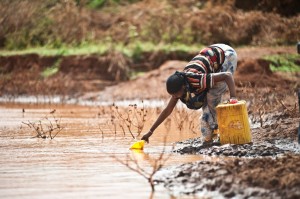People not just places determine the right choice for agricultural water storage in Africa
The Africa Agriculture Science Week (AASW) convened by the Forum for Agricultural Research in Africa (FARA) and hosted by the Government of Ghana is taking place in Accra this week under the theme “Africa feeding Africa through agricultural science and innovation”.
IWMI’s research is contributing to the findings of agricultural water management solutions for Africa’s smallholder farmers.

Photo credit: IFRC/Michael Tsegaye
Millions of farmers depend on rain fed agriculture. In sub-Saharan Africa 95% of cropland is rain fed. But in many places this form of agriculture will be challenged by climate change.
By providing water when it is needed small scale water storage may help many farmers adapt to this challenge. In Rajasthan, India, for example, the construction of 10,000 water harvesting structures – essentially farm ponds and tanks – has benefited almost 70,000 people, allowing farmers, who suffered from severe water shortage, to now grow vegetables and cash crops in the dry season. In China the construction of 90,000 underground water storage tanks has benefited a million farmers.
Reservoirs, aquifers, soil and wetlands all store water. But not every option works in every context. In fact the impact of different storage types on poverty and food security can vary drastically. To determine what this best option is, a number of variables need to be considered. These include the cost of the water storage, environmental and health risks, politics and social-economic factors.
“In sub-Saharan Africa we see all of these storage options being widely used already”, says Matthew McCartney, Principal researcher at the International Water Management Institute (IWMI). “But often a lack of information and minimal and ad hoc planning mean that these options are not used to their full potential. In any given location the impact of different storage can vary significantly. There is a lack of both data and scientific knowledge.”
Assessing storage
Newly published IWMI research addresses these issues by developing a framework for assessing the need and effectiveness of a range of different water storage options, including large reservoirs, ponds and tanks, aquifers and soil moisture. All of these options have their pros and cons, which depend on the conditions of specific sites and also the way they are managed and planned.
The framework’s strength is that it is based on variety of broad criteria, such as reliability, resilience and vulnerability. This is then matched with other variables such as the amount of water available at certain times of year, the size of the local population and how well the various water storage options are likely to perform. The approach is a rapid assessment tool that provides a starting point for more detailed planning of water storage options.
The researchers applied the tool to sub-Saharan Africa, looking specifically at the Volta Basin and the Ethiopian portion of the Nile. They found that within Ethiopia the greatest need for water storage exists in the Central Highlands, while in Ghana the highest need exists in the south and in patches the North. In other words the results showed a clear need not within the driest areas but in those that are most densely populated. In these areas there is still a significant need for storage in order to fulfill the requirements of large rural populations that depend on agriculture for their livelihoods.
Decreased effectiveness, increased vulnerability
As expected the researchers found differences in how climate change will impact the different types of storage in Ghana and Ethiopia, but they also found a common general tendency.
“For the scenario simulated, in both basins climate change will lead to a decrease in the effectiveness and an increase in vulnerability of water storage”, says McCartney. “The change will be most rapid in the Volta Basin but in the long run the water storage in both basins will be adversely affected.
Need for appropriate choices
Overall the study conveys the message: to improve the performance of agricultural water storage in the future closer attention must be paid to planning and management.
Constructing ill-conceived water storage today is a waste of financial resources and might even worsen climate change impacts, when the opposite is needed. In contrast careful consideration of integrated approaches to water storage can help lift farmers out of poverty and help make them more resilient to climate change.
“Making appropriate choice is key to planning and management of water storage”, says McCartney.” This tool represents a first step towards more systematic decision-making, more targeted and hopefully sustainable interventions. Hopefully it will lead to visible benefits for rural communities.”
McCartney, Matthew; Rebelo, Lisa-Maria; Xenarios, Stefanos; Smakhtin, Vladimir. 2013. Agricultural water storage in an era of climate change: assessing need and effectiveness in Africa. Colombo, Sri Lanka: International Water Management Institute (IWMI). 29p. (IWMI Research Report 152)
[hr top=”yes”/]
About the author:
Anna Deinhard is a Communications Fellow at the International Water Management Institute (IWMI). She has an MSc in Environmental Sciences from Linkoping University, Sweden, specialized in water and development.

